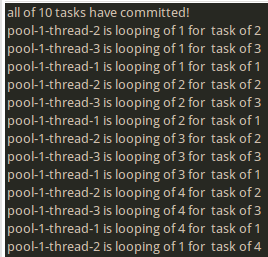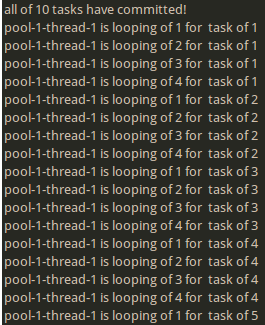Java多线程——Executors和线程池
线程池的概念与Executors类的应用
1.创建固定大小的线程池
package java_thread;
import java.util.concurrent.ExecutorService;
import java.util.concurrent.Executors;
import java.util.concurrent.TimeUnit;
public class ThreadPoolTest {
/**
* @param args
*/
public static void main(String[] args) {
ExecutorService threadPool = Executors.newFixedThreadPool(3);
// ExecutorService threadPool = Executors.newCachedThreadPool();
// ExecutorService threadPool = Executors.newSingleThreadExecutor();
for(int i=1;i<=10;i++){
final int task = i;
threadPool.execute(new Runnable(){
@Override
public void run() {
for(int j=1;j<=4;j++){
try {
Thread.sleep(20);
} catch (InterruptedException e) {
// TODO Auto-generated catch block
e.printStackTrace();
}
System.out.println(Thread.currentThread().getName() + " is looping of " + j + " for task of " + task);
}
}
});
}
System.out.println("all of 10 tasks have committed! ");
//threadPool.shutdownNow();
// Executors.newScheduledThreadPool(3).scheduleAtFixedRate(
// new Runnable(){
// @Override
// public void run() {
// System.out.println("bombing!");
//
// }},
// 6,
// 2,
// TimeUnit.SECONDS);
}
}

2.创建缓存线程池
ExecutorService threadPool = Executors.newCachedThreadPool();

3.创建单一线程池
ExecutorService threadPool = Executors.newSingleThreadExecutor();

关闭线程池
shutdown与shutdownNow的比较
threadPool.shutdownNow();
用线程池启动定时器
调用ScheduledExecutorService的schedule方法,返回的ScheduleFuture对象可以取消任务。
支持间隔重复任务的定时方式,不直接支持绝对定时方式,需要转换成相对时间方式。
Executors.newScheduledThreadPool(3).scheduleAtFixedRate( //多久气候执行,每隔多久执行
new Runnable(){
@Override
public void run() {
System.out.println("bombing!");
}},
6,
2,
TimeUnit.SECONDS);
本文只发表于博客园和tonglin0325的博客,作者:tonglin0325,转载请注明原文链接:https://www.cnblogs.com/tonglin0325/p/6262640.html



